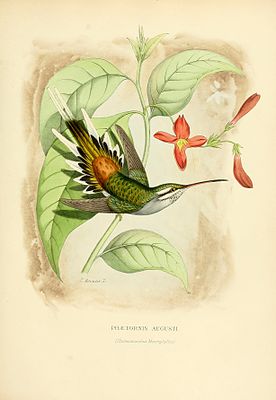Gray-bellied shadow hummingbird
| Gray-bellied shadow hummingbird | ||||||||||||
|---|---|---|---|---|---|---|---|---|---|---|---|---|

Gray-bellied shadow hummingbird, illustration by Louis Victor Bevalet (1808–) |
||||||||||||
| Systematics | ||||||||||||
|
||||||||||||
| Scientific name | ||||||||||||
| Phaethornis augusti | ||||||||||||
| ( Bourcier , 1847) |
The gray-bellied shadow hummingbird ( Phaethornis augusti ), sometimes also called cap hermit , is a species of bird from the hummingbird family (Trochilidae). The species has a large distribution area in the South American countries Colombia , Venezuela , Guyana and Brazil . The IUCN classifies the population as “not at risk” ( least concern ).
features
The gray-bellied shadow hummingbird reaches a body length of about 13.2 cm with a body weight of only approx. 5.3 g, with the slightly curved beak being 3.6 cm long. The base of the lower mandible is red. The top is gray-brown. The rump and the upper tail-coverts are light reddish-brown. The black face mask is embedded by a white line behind the eyes and cheeks. The pale brown-gray underside is traversed by a white line on the central throat feathers. The bronze-green middle part of the tail feathers is replaced by long white tips. The rest of the tail is dark and streaked with white.
behavior
They change from one flower to the next in quick succession and visit them regularly (traplining). For this they mainly use plants from the lower strata . They are particularly curious and trusting. Occasionally they hover in front of the face of observers, then dance away with a quivering, wagging tail and after a short time come back for a second viewing. They willingly fly into open windows and doors of houses and vehicles and observe each other e.g. B. buzzing in front of the mirror. They collect small insects or spiders from leafless branches, leaves and cobwebs and scurry from here to there, always in a hurry. The males sing from scattered courtship areas , as is the case with other species of this genus.
Reproduction
The cone-shaped nest with dangling threads or fibers is attached to large leaves on the shoulder of roads or bridge passages. In Aragua they breed from December to April.
Vocalizations
The call sounds like a very high -pitched haunted tsio-tsio, sis-sis-sis , which you repeat over and over again up to 40 times. They bob their tails down while singing. This can be done alone or in groups.
distribution and habitat
They are mostly found in the thicket and near dry to slightly damp forest edges. They are also very rarely found in damp forests. On the Orinoco, they are also present in gallery forests or on Mauritia crops. They are particularly common in the arid areas of the Henri Pittier National Park . They move at heights between 250 and 2500 meters.
Subspecies
There are three known subspecies:
- Phaethornis augusti curiosus Wetmore , 1956 - This subspecies occurs in the Sierra Nevada de Santa Marta in northeastern Colombia. It is much paler than the nominate form. The throat and the under tail-coverts are more white, the upper side more greyish with less green tint.
- Phaethornis augusti augusti ( Bourcier , 1847) - The nominate form occurs in the east of Colombia, the Serranía de la Macarena up to the north of Venezuela.
- Phaethornis augusti incanescens ( Simon , 1921) - This subspecies is distributed in the Tepuis in southeastern Venezuela, as well as in the adjacent areas in western Guyana and northern Brazil. The bronze-green middle part of the tail feathers of the other subspecies is colored reddish brown in this subspecies.
Etymology and history of research
Jules Bourcier described the gray-bellied shadow hummingbird under the name Trochilus augusti . The type specimen comes from the Caracas area . In 1827 William Swainson introduced the genus Phaethornis for the Eastern long-tailed shadow hummingbird (Phaethornis superciliosus ( Linnaeus , 1766)), which was later assigned to the gray-bellied shadow hummingbird. The term “Phaethornis” is derived from the Greek words “phaethōn Φαέθων ” for “the shining one, the shining one” and “órnis όρνις ” for “bird”. The name »augusti« is dedicated to Auguste Sallé (1820–1896), who caught the type specimen and studied its behavior. "Curiosus" is the Latin word for "curious". "Incanescens" is also of Latin origin and means "grayish, gray".
literature
- Steven Leon Hilty, John A. Gwynne, Guy Tudor : Birds of Venezuela . Princeton University Press, Princeton 2002, ISBN 0-691-09250-8 ( online [accessed September 19, 2015]).
- James A. Jobling: Helm Dictionary of Scientific Bird Names . Christopher Helm, London 2010, ISBN 978-1-4081-2501-4 .
- Jules Bourcier: Description of the trois nouvelles espèces d'Osiseau-Mouches . In: Annales des sciences physiques et naturelles, d'agriculture et d'industrie . tape 10 , 1847, p. 623-624 ( online [accessed September 19, 2015]).
- Alexander Wetmore: Additional forms of birds from Panama and Colombia . In: Proceedings of the Biological Society of Washington . tape 69 , 1956, pp. 123–126 ( online [accessed September 19, 2015]).
- Eugène Simon: Histoire naturelle des Trochilidae (synopsis et catalog) . L. Mulo, Paris 1921 ( online [accessed September 19, 2015]).
- William Swainson: A Synopsis of the Birds discovered in Mexico by W. Bullock, FLS and HS and Mr. William Bullock, jun. In: The Philosophical magazine: or Annals of chemistry, mathematics, astronomy, natural history and general science. tape 1 , no. 85 , 1827, pp. 433-442 ( online [accessed September 19, 2015]).
Web links
- Phaethornis augusti inthe IUCN Red List of Threatened Species 2014.3. Listed by: BirdLife International, 2012. Retrieved September 19, 2015.
- BirdLife International: Species Factsheet - Sooty-capped Hermit ( Phaethornis augusti ) . Retrieved September 19, 2015.
- Videos, photos and sound recordings for Sooty-capped Hermit (Phaethornis augusti) in the Internet Bird Collection
- Gray-bellied shadow hummingbird ( Phaethornis augusti ) at Avibase; Retrieved September 19, 2015.
- Phaethornis augusti in the Integrated Taxonomic Information System (ITIS)
- xeno-canto: sound recordings - gray-bellied shadow hummingbird ( Phaethornis augusti )
